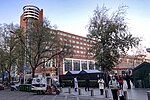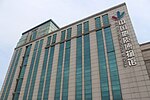Peking Union Medical College Hospital
1921 establishments in ChinaAsian hospital stubsDongcheng District, BeijingHospitals established in 1921Hospitals in Beijing ... and 3 more
People's Republic of China building and structure stubsRockefeller FoundationXicheng District

Peking Union Medical College Hospital (PUMCH), also known as Beijing Xiehe Hospital (Chinese: 北京协和医院), is a large teaching hospital in Beijing, China. It was founded in 1921 by Rockefeller Foundation and is affiliated to both Peking Union Medical College (PUMC) and Chinese Academy of Medical Sciences (CAMS). During the Cultural Revolution, it was renamed the "Anti-imperialist Hospital". It has two locations: the Dongdan Campus in Wangfujing, Dongcheng District and the Xidan Campus in Damucang Hutong, Xicheng District.The last emperor of the Great Qing Dynasty, Aisin-Gioro Puyi, died at the Peking Union Medical College Hospital on October 17, 1967.
Excerpt from the Wikipedia article Peking Union Medical College Hospital (License: CC BY-SA 3.0, Authors, Images).Peking Union Medical College Hospital
Dongxie Str, Xicheng District Xichang'anjie (首都功能核心区)
Geographical coordinates (GPS) Address Nearby Places Show on map
Geographical coordinates (GPS)
| Latitude | Longitude |
|---|---|
| N 39.9139 ° | E 116.3681 ° |
Address
东斜街
Dongxie Str
100032 Xicheng District, Xichang'anjie (首都功能核心区)
Beijing, China
Open on Google Maps











